

Compact Muon Solenoid
LHC, CERN
| CMS-PAS-TOP-18-009 | ||
| Measurement of top quark pair production in association with a Z boson in proton-proton collisions at √s= 13 TeV | ||
| CMS Collaboration | ||
| March 2019 | ||
| Abstract: A measurement of the cross section of top quark pair production in association with a Z boson using proton-proton collisions at a center-of-mass energy of 13 TeV at the LHC is performed. The data sample corresponds to an integrated luminosity of 77.5 fb−1, collected by the CMS experiment during 2016 and 2017. The measurement is performed in the three- and four-lepton final states. The production cross section is measured to be σ(t¯tZ)= 1.00+0.06−0.05 (stat)+0.07−0.06 (syst) pb. Differential cross sections are measured as a function of the transverse momentum of the Z boson and the angular distribution of the decay lepton. New stringent limits on the anomalous couplings of the top quark to the Z boson are obtained, including estimates of Wilson coefficients of standard model effective field theory. | ||
|
Links:
CDS record (PDF) ;
CADI line (restricted) ;
These preliminary results are superseded in this paper, JHEP 03 (2020) 056. The superseded preliminary plots can be found here. |
||
| Figures | |
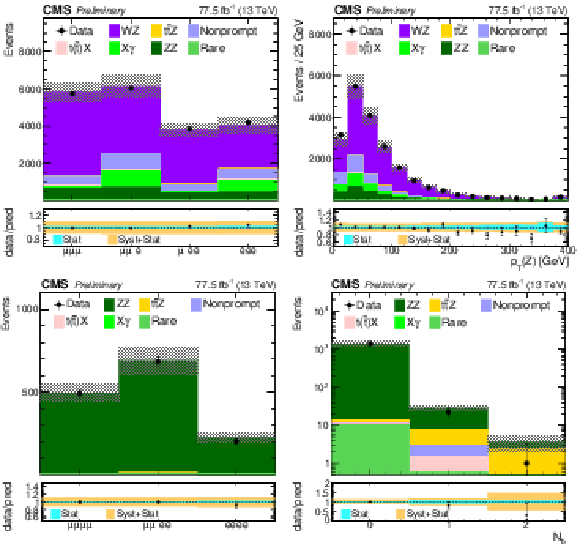
png pdf |
Figure 1:
Distributions of the predicted and observed yields versus lepton flavor (upper left), and the reconstructed transverse momentum of the Z boson candidates (upper right) in the WZ-enriched data control region, and versus lepton flavor (lower left) and number of b jets (lower right) in the ZZ-enriched control region. The shaded band represents the total uncertainty in the prediction of the signal and background. The lower panels show the ratio of the data to the theoretical predictions. The inner band gives the statistical uncertainty in the ratio, and the outer band the total uncertainty. |
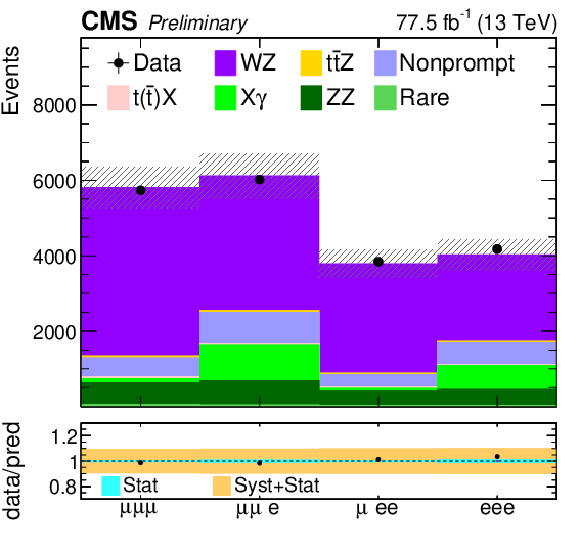
png pdf |
Figure 1-a:
Distribution of the predicted and observed yields versus lepton flavor in the WZ-enriched data control region.The shaded band represents the total uncertainty in the prediction of the signal and background. The lower panel shows the ratio of the data to the theoretical predictions. The inner band gives the statistical uncertainty in the ratio, and the outer band the total uncertainty. |

png pdf |
Figure 1-b:
Distribution of the reconstructed transverse momentum of the Z boson candidates in the WZ-enriched data control region. The shaded band represents the total uncertainty in the prediction of the signal and background. The lower panel shows the ratio of the data to the theoretical predictions. The inner band gives the statistical uncertainty in the ratio, and the outer band the total uncertainty. |

png pdf |
Figure 1-c:
Distribution of the predicted and observed yields versus lepton flavor in the ZZ-enriched control region. The shaded band represents the total uncertainty in the prediction of the signal and background. The lower panel shows the ratio of the data to the theoretical predictions. The inner band gives the statistical uncertainty in the ratio, and the outer band the total uncertainty. |
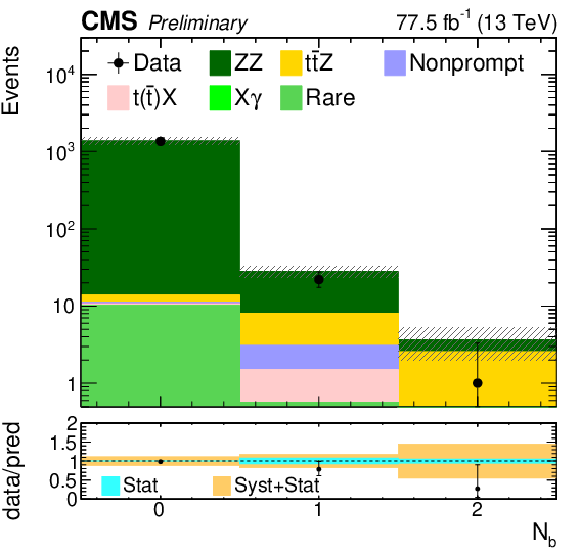
png pdf |
Figure 1-d:
Distribution of the number of b jets in the ZZ-enriched control region. The shaded band represents the total uncertainty in the prediction of the signal and background. The lower panel shows the ratio of the data to the theoretical predictions. The inner band gives the statistical uncertainty in the ratio, and the outer band the total uncertainty. |

png pdf |
Figure 2:
Distributions of the predicted and observed yields in regions enriched with nonprompt lepton backgrounds in t¯t-like processes as a function of the lepton flavors (left), the pT of the lowest-pT lepton (middle), and Nb (right). The shaded band represents the total uncertainty in the prediction of the background and the signal processes. The lower panels show the ratio of the data to the predictions from simulation. The inner band gives the statistical uncertainty in the ratio, and the outer band the total uncertainty. See Section 4 for the definition of each background category. |
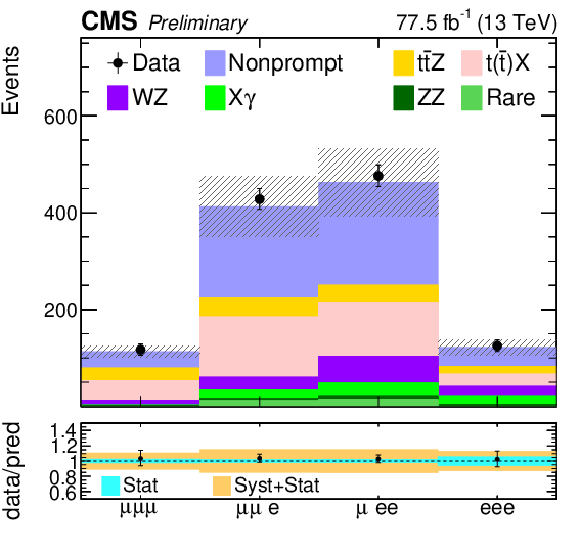
png pdf |
Figure 2-a:
Distribution of the predicted and observed yields in regions enriched with nonprompt lepton backgrounds in t¯t-like processes as a function of the lepton flavors. The shaded band represents the total uncertainty in the prediction of the background and the signal processes. The lower panels show the ratio of the data to the predictions from simulation. The inner band gives the statistical uncertainty in the ratio, and the outer band the total uncertainty. See Section 4 for the definition of each background category. |

png pdf |
Figure 2-b:
Distribution of the predicted and observed yields in regions enriched with nonprompt lepton backgrounds in t¯t-like processes as a function of the pT of the lowest-pT lepton. The shaded band represents the total uncertainty in the prediction of the background and the signal processes. The lower panels show the ratio of the data to the predictions from simulation. The inner band gives the statistical uncertainty in the ratio, and the outer band the total uncertainty. See Section 4 for the definition of each background category. |
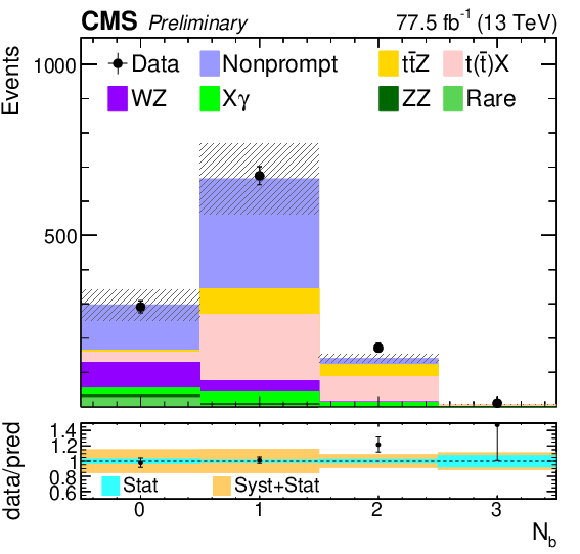
png pdf |
Figure 2-c:
Distribution of the predicted and observed yields in regions enriched with nonprompt lepton backgrounds in t¯t-like processes as a function of Nb. The shaded band represents the total uncertainty in the prediction of the background and the signal processes. The lower panels show the ratio of the data to the predictions from simulation. The inner band gives the statistical uncertainty in the ratio, and the outer band the total uncertainty. See Section 4 for the definition of each background category. |
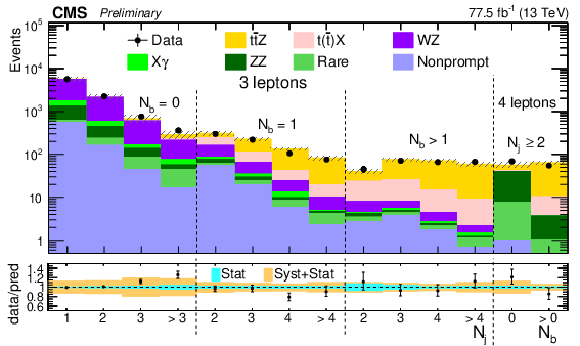
png pdf |
Figure 3:
Observed data as a function of Nj and Nb for events with 3 and 4 leptons, compared to the simulated signal and background yields, as obtained from the fit. The hatched band shows the total uncertainty associated with the signal and background predictions, as obtained from the fit. |
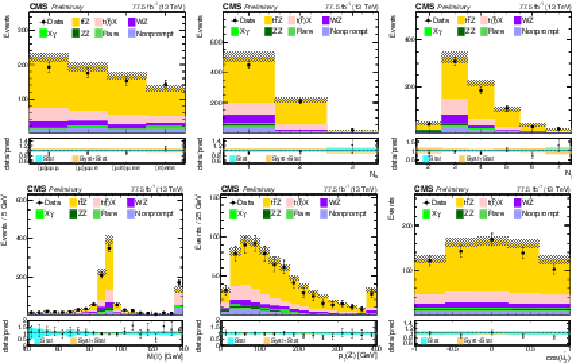
png pdf |
Figure 4:
Observed data in a t¯tZ dominated region, compared to signal and background yields, as obtained from the fit. Event distributions are shown as a function of the lepton flavor (upper left), Nb (upper middle), Nj (upper right), dilepton invariant mass m(ℓℓ) (lower left), pT(Z) (lower middle), and cosθ∗Z (lower right). The hatched band shows the total uncertainty associated with the signal and background predictions, as obtained from the fit. |
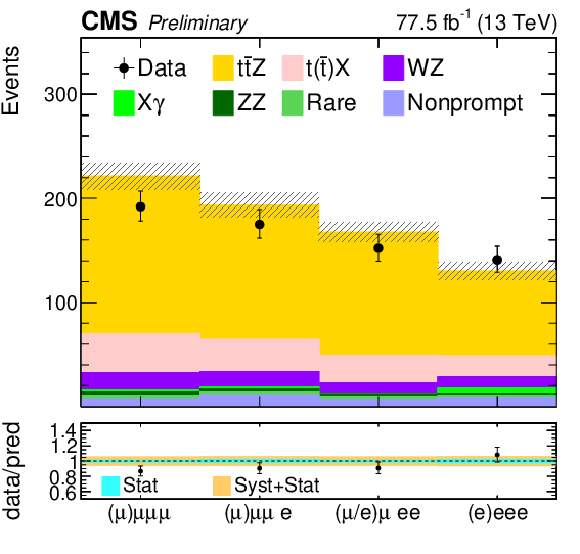
png pdf |
Figure 4-a:
Observed data in a t¯tZ dominated region, compared to signal and background yields, as obtained from the fit. Shown is the event distribution as a function of the lepton flavor. The hatched band shows the total uncertainty associated with the signal and background predictions, as obtained from the fit. |
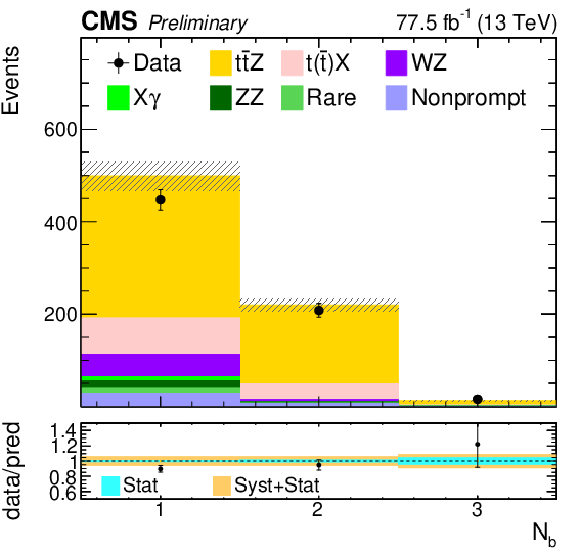
png pdf |
Figure 4-b:
Observed data in a t¯tZ dominated region, compared to signal and background yields, as obtained from the fit. Shown is the event distribution as a function of Nb. The hatched band shows the total uncertainty associated with the signal and background predictions, as obtained from the fit. |
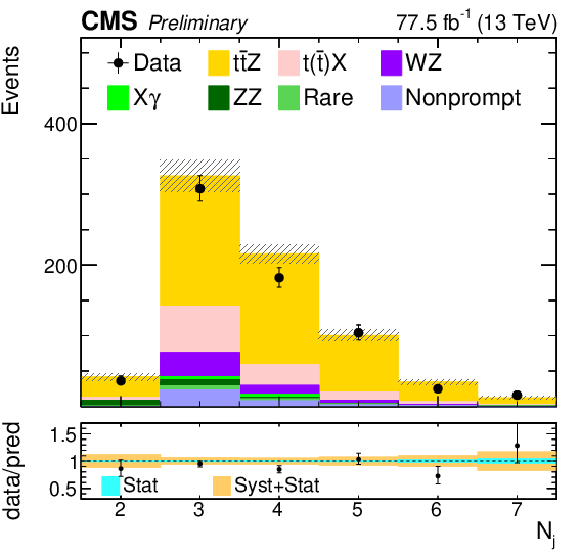
png pdf |
Figure 4-c:
Observed data in a t¯tZ dominated region, compared to signal and background yields, as obtained from the fit. Shown is the event distribution as a function of Nj. The hatched band shows the total uncertainty associated with the signal and background predictions, as obtained from the fit. |

png pdf |
Figure 4-d:
Observed data in a t¯tZ dominated region, compared to signal and background yields, as obtained from the fit. Shown is the event distribution as a function of the dilepton invariant massThe hatched band shows the total uncertainty associated with the signal and background predictions, as obtained from the fit. |

png pdf |
Figure 4-e:
Observed data in a t¯tZ dominated region, compared to signal and background yields, as obtained from the fit. Shown is the event distribution as a function of pT(Z). The hatched band shows the total uncertainty associated with the signal and background predictions, as obtained from the fit. |
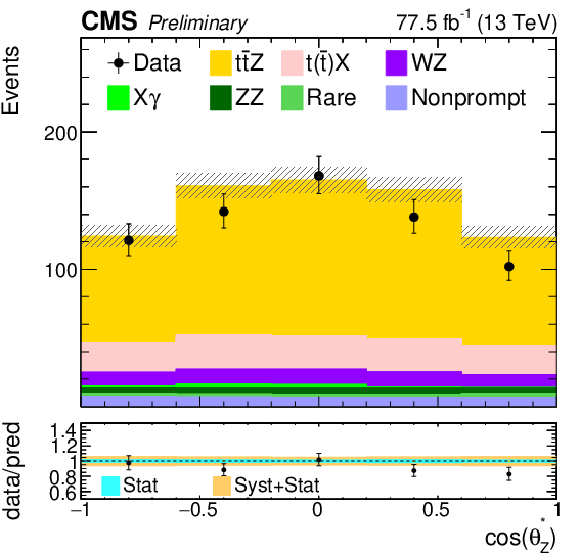
png pdf |
Figure 4-f:
Observed data in a t¯tZ dominated region, compared to signal and background yields, as obtained from the fit. Shown is the event distribution as a function of cosθ∗Z. The hatched band shows the total uncertainty associated with the signal and background predictions, as obtained from the fit. |

png pdf |
Figure 5:
Measured differential t¯tZ production cross sections in the full phase space as a function of the transverse momentum pT(Z) of the Z boson (top row), and cosθ∗Z, as defined in the text (bottom row). Shown are the absolute (left) and normalized (right) cross sections. The data are represented by the points. The inner (outer) vertical bars indicate the statistical (total) uncertainties, respectively. The histogram shows the prediction from the MadGraph 5_aMC@NLO Monte Carlo simulation, and the hatched band indicates the theory uncertainties in the prediction. The lower planels display the ratio between prediction and measurement. |

png pdf |
Figure 5-a:
Measured differential t¯tZ production cross section in the full phase space as a function of the transverse momentum pT(Z) of the Z boson. Shown is the absolute cross section. The data are represented by the points. The inner (outer) vertical bars indicate the statistical (total) uncertainties, respectively. The histogram shows the prediction from the MadGraph 5_aMC@NLO Monte Carlo simulation, and the hatched band indicates the theory uncertainties in the prediction. The lower planels display the ratio between prediction and measurement. |

png pdf |
Figure 5-b:
Measured differential t¯tZ production cross section in the full phase space as a function of the transverse momentum pT(Z) of the Z boson. Shown is the normalized cross section. The data are represented by the points. The inner (outer) vertical bars indicate the statistical (total) uncertainties, respectively. The histogram shows the prediction from the MadGraph 5_aMC@NLO Monte Carlo simulation, and the hatched band indicates the theory uncertainties in the prediction. The lower planels display the ratio between prediction and measurement. |

png pdf |
Figure 5-c:
Measured differential t¯tZ production cross section in the full phase space as a function of cosθ∗Z, as defined in the text. Shown is the absolute cross section. The data are represented by the points. The inner (outer) vertical bars indicate the statistical (total) uncertainties, respectively. The histogram shows the prediction from the MadGraph 5_aMC@NLO Monte Carlo simulation, and the hatched band indicates the theory uncertainties in the prediction. The lower planels display the ratio between prediction and measurement. |
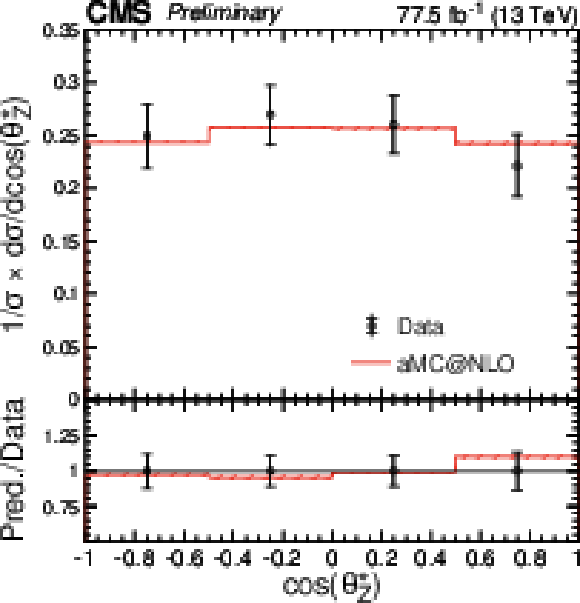
png pdf |
Figure 5-d:
Measured differential t¯tZ production cross section in the full phase space as a function of cosθ∗Z, as defined in the text. Shown is the normalized cross section. The data are represented by the points. The inner (outer) vertical bars indicate the statistical (total) uncertainties, respectively. The histogram shows the prediction from the MadGraph 5_aMC@NLO Monte Carlo simulation, and the hatched band indicates the theory uncertainties in the prediction. The lower planels display the ratio between prediction and measurement. |

png pdf |
Figure 6:
Predicted and observed yields (post-fit) for the combined 2016 and 2017 data sets in the control and signal regions. In the Nℓ= 3 control and signal regions (bins 1-12), each of the 4 pT(Z) categories is further split into 3 cosθ∗Z bins. Due to the lower expected event count in the Nℓ=4 signal regions (bins 13-15) no categorization in terms of cosθ∗Z is applied. The red dashed line shows the best-fit point to the observed result in one of the EFT planes. |
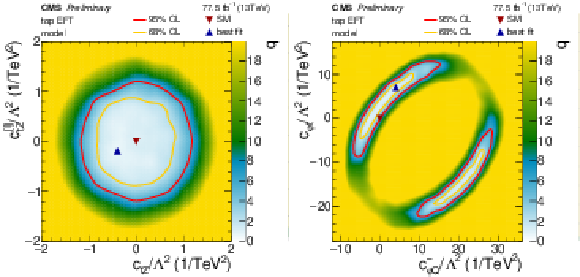
png pdf |
Figure 7:
Results of scans in two 2D planes in the EFT interpretation. The color map reflects the negative log-likelihood ratio q w.r.t the best-fit value. The yellow and red dashed lines indicate one and two standard deviations from the best-fit value. |

png pdf |
Figure 7-a :
Results of scans in the cItZ-ctZ plane in the EFT interpretation. The color map reflects the negative log-likelihood ratio q w.r.t the best-fit value. The yellow and red dashed lines indicate one and two standard deviations from the best-fit value. |

png pdf |
Figure 7-b :
Results of scans in the cϕt-c−ϕQ plane in the EFT interpretation. The color map reflects the negative log-likelihood ratio q w.r.t the best-fit value. The yellow and red dashed lines indicate one and two standard deviations from the best-fit value. |

png pdf |
Figure 8:
Results of scans in the electroweak dipole moment plane (left) and axial-vector and vector current coupling plane (right). The color map reflects the negative log-likelihood ratio w.r.t the best-fit value. The yellow and red dashed lines indicate one and two standard deviations from the best-fit value. The area between the gray ellipses in the axial-vector and vector current coupling plane corresponds to the observed 68% C.L. area from a previous CMS result [76]. |

png pdf |
Figure 8-a:
Result of a scan in the electroweak dipole moment plane. The color map reflects the negative log-likelihood ratio w.r.t the best-fit value. The yellow and red dashed lines indicate one and two standard deviations from the best-fit value. The area between the gray ellipses in the axial-vector and vector current coupling plane corresponds to the observed 68% C.L. area from a previous CMS result [76]. |

png pdf |
Figure 8-b:
Result of a scan in the axial-vector and vector current coupling plane. The color map reflects the negative log-likelihood ratio w.r.t the best-fit value. The yellow and red dashed lines indicate one and two standard deviations from the best-fit value. The area between the gray ellipses in the axial-vector and vector current coupling plane corresponds to the observed 68% C.L. area from a previous CMS result [76]. |

png pdf |
Figure 9:
Log-likelihood ratios for 1D scans of Wilson coefficients. Wilson coefficients that are not shown on the respective plot are set to 0. The cyan and orange colored areas correspond to the 68% and 95% confidence level intervals around the best-fit value, respectively. The red triangle indicates the SM value. Previously excluded regions at 95% CL [4] (if available) are indicated by the gray hatched band. Indirect constraints from [77] are shown as light red hatched band. |
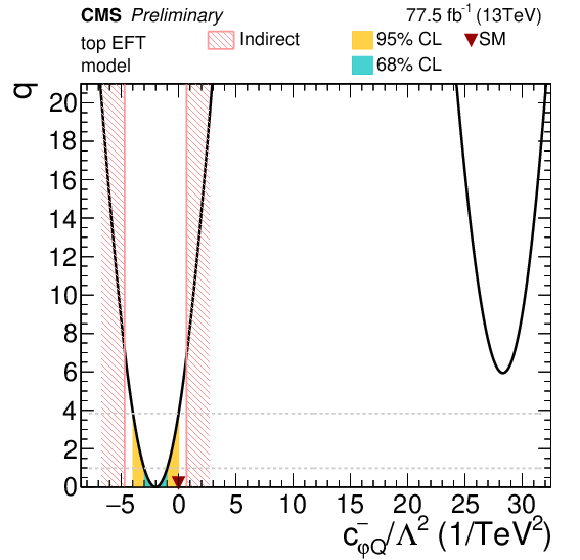
png pdf |
Figure 9-a:
Log-likelihood ratio for a scan of the c−ϕQ Wilson coefficient. Other Wilson coefficients that are not shown on the respective plot are set to 0. The cyan and orange colored areas correspond to the 68% and 95% confidence level intervals around the best-fit value, respectively. The red triangle indicates the SM value. Previously excluded regions at 95% CL [4] (if available) are indicated by the gray hatched band. Indirect constraints from [77] are shown as light red hatched band. |
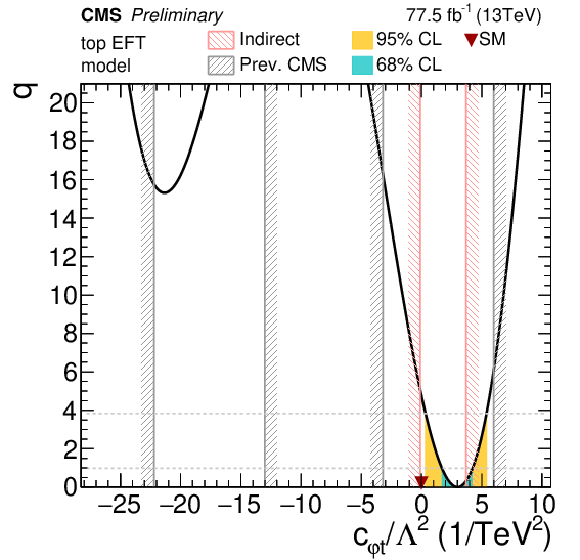
png pdf |
Figure 9-b:
Log-likelihood ratio for a scan of the cϕt Wilson coefficient. Other Wilson coefficients that are not shown on the respective plot are set to 0. The cyan and orange colored areas correspond to the 68% and 95% confidence level intervals around the best-fit value, respectively. The red triangle indicates the SM value. Previously excluded regions at 95% CL [4] (if available) are indicated by the gray hatched band. Indirect constraints from [77] are shown as light red hatched band. |
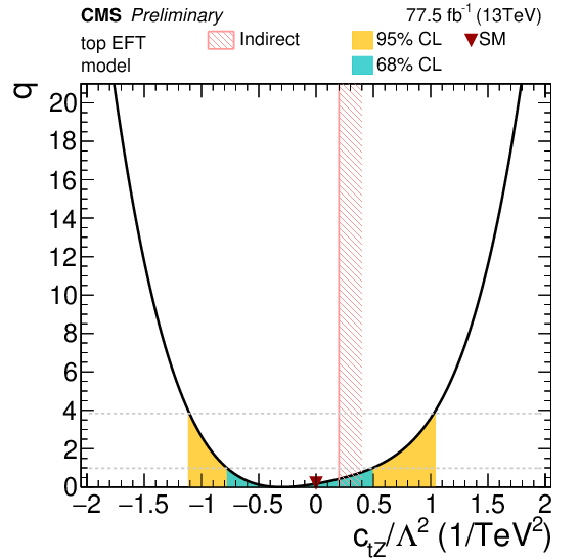
png pdf |
Figure 9-c:
Log-likelihood ratio for a scan of the ctZ Wilson coefficient. Other Wilson coefficients that are not shown on the respective plot are set to 0. The cyan and orange colored areas correspond to the 68% and 95% confidence level intervals around the best-fit value, respectively. The red triangle indicates the SM value. Previously excluded regions at 95% CL [4] (if available) are indicated by the gray hatched band. Indirect constraints from [77] are shown as light red hatched band. |
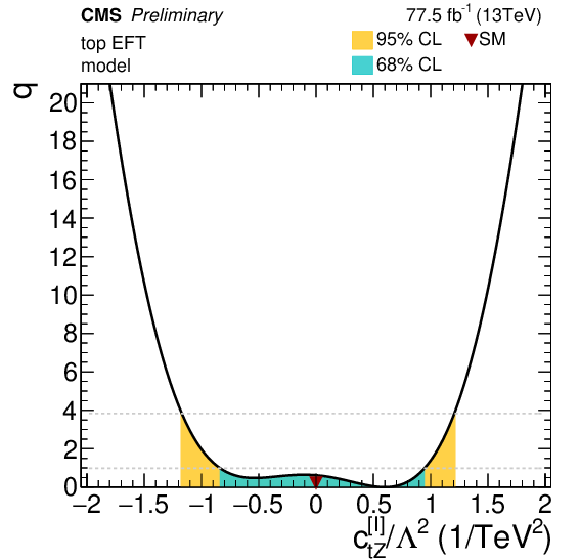
png pdf |
Figure 9-d:
Log-likelihood ratio for a scan of the cItZ Wilson coefficient. Other Wilson coefficients that are not shown on the respective plot are set to 0. The cyan and orange colored areas correspond to the 68% and 95% confidence level intervals around the best-fit value, respectively. The red triangle indicates the SM value. Previously excluded regions at 95% CL [4] (if available) are indicated by the gray hatched band. Indirect constraints from [77] are shown as light red hatched band. |

png pdf |
Figure 10:
Log-likelihood ratios for 1D scans of anomalous couplings. C1,V=0.24 (SM value) for the scan of C1,A (top left) and C1,A=−0.60 (SM value) for the scan of C1,V (top right). The cyan and orange colored areas correspond to the 68% and 95% confidence level intervals around the best-fit value, respectively. The red triangles indicate the SM values. |

png pdf |
Figure 10-a:
Log-likelihood ratios for a scan of the C1,A anomalous coupling. C1,V=0.24 (SM value) for the scan. The cyan and orange colored areas correspond to the 68% and 95% confidence level intervals around the best-fit value, respectively. The red triangles indicate the SM values. |
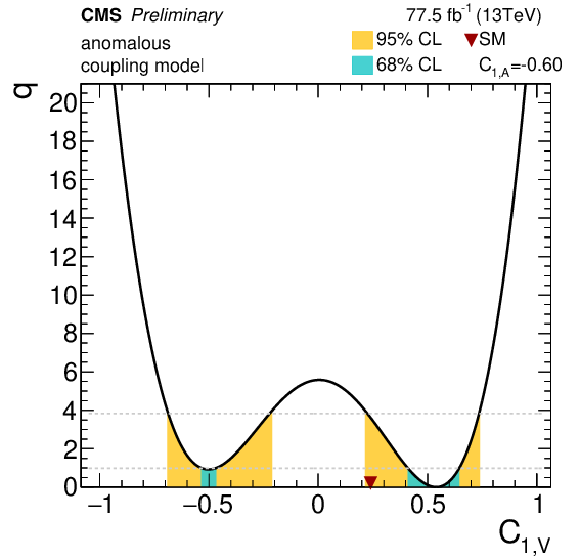
png pdf |
Figure 10-b:
Log-likelihood ratios for a scan of the C1,V anomalous coupling. C1,A=−0.60 (SM value) for the scan. The cyan and orange colored areas correspond to the 68% and 95% confidence level intervals around the best-fit value, respectively. The red triangles indicate the SM values. |
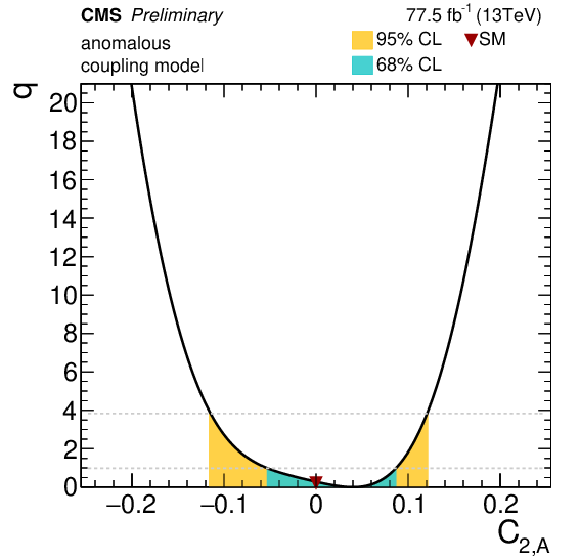
png pdf |
Figure 10-c:
Log-likelihood ratios for a scan of the C2,A anomalous coupling. The cyan and orange colored areas correspond to the 68% and 95% confidence level intervals around the best-fit value, respectively. The red triangles indicate the SM values. |

png pdf |
Figure 10-d:
Log-likelihood ratios for a scan of the C2,V anomalous coupling. The cyan and orange colored areas correspond to the 68% and 95% confidence level intervals around the best-fit value, respectively. The red triangles indicate the SM values. |
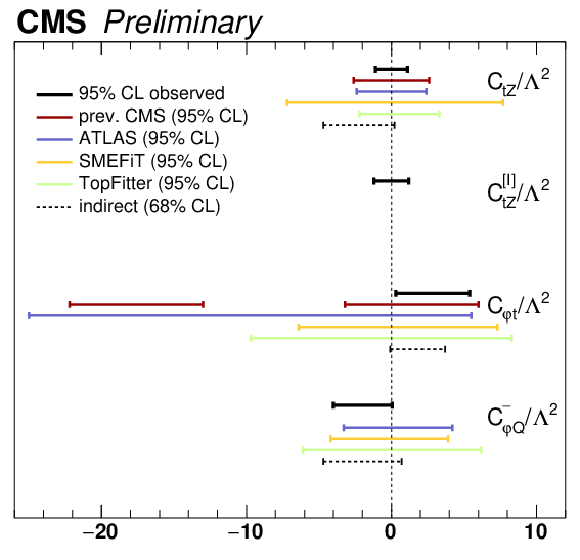
png pdf |
Figure 11:
Comparison of the observed 95% confidence level intervals (solid black) with the previous CMS result based on the inclusive cross section measurement [4] (red), the most recent ATLAS result [5] (blue), direct limits from the SMEFiT framework [78] (orange) and the TopFitter collaboration [79] (green), as well as indirect limits from electroweak data [77] (dashed black) on the Wilson coefficients. |
| Tables | |

png pdf |
Table 1:
Event generators used to simulate events for the various processes. The version of the NNPDF set used for the hard process is shown for samples corresponding to the 2016 (2017) data sets. |
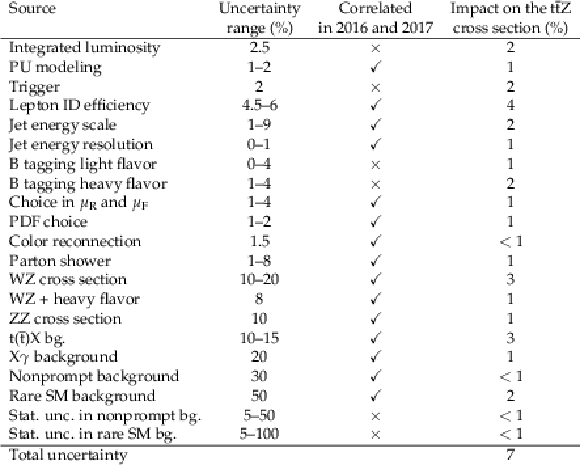
png pdf |
Table 2:
Summary of the sources, magnitudes, treatments, and effects of the systematic uncertainties in the final t¯tZ cross section measurement. The first column indicates the source of the uncertainties, the second column shows the corresponding input uncertainty range on each background source and the signal. The third column indicates how correlations are treated between uncertainties in the 2016 and the 2017 data, and the fourth column shows the resulting uncertainty in the t¯tZ cross section. |

png pdf |
Table 3:
Measured t¯tZ signal strengths for events with 3 and 4 leptons, and the value from the combined fit. |
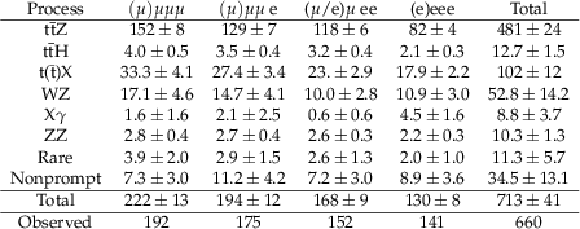
png pdf |
Table 4:
Predicted and observed yields, and total uncertainties in the signal-enriched sample of events. |

png pdf |
Table 5:
Definition of the signal and control regions. |

png pdf |
Table 6:
Expected and observed 68% and 95% CL intervals from this measurement for the listed Wilson coefficients. Constraints from a previous CMS measurement [4] and indirect constraints from precision electroweak data [77] are shown for comparison. |
| Summary |
| A measurement has been presented of top quark pair production in association with a Z boson using a data sample of proton-proton collisions at √s= 13 TeV, corresponding to an integrated luminosity of 77.5 fb−1, collected by the CMS detector. The analysis is performed in the three- and four-lepton final states using analysis categories defined with jet and b jet multiplicities. Data samples enriched in background processes are used to validate predictions, as well as to constrain their uncertainties. Thanks to the larger data set used and reduced systematic uncertainties such as those associated with the lepton identification, the precision on the measured cross section is substantially improved with respect to previous measurements reported in Refs. [4,5]. The measured inclusive cross section is σ(tˉtZ)= 1.00+0.06−0.05 (stat)+0.07−0.06 (syst) pb, in agreement with the standard model prediction. This is not only the most precise measurement today, but also the first measurement with better precision compared to the theoretical prediction at NLO in QCD. Furthermore, absolute and normalized differential cross sections for the transverse momentum of the Z boson as well as cosθ∗Z are presented for the first time. The SM predictions at NLO are found to be in good agreement with the measured inclusive and differential cross sections. The measurement is also interpreted in terms of anomalous interactions of the t quark with the Z boson. Confidence intervals for anomalous vector and axial-vector current couplings and dipole moment interactions are presented. Wilson coefficients in the top quark effective field theory are similarly constrained. |
| References | ||||
| 1 | D. de Florian et al. | Handbook of LHC Higgs cross sections: 4. deciphering the nature of the Higgs sector | CERN-2017-002-M | 1610.07922 |
| 2 | O. Bessidskaia Bylund et al. | Probing top quark neutral couplings in the Standard Model Effective Field Theory at NLO in QCD | JHEP 05 (2016) 052 | 1601.08193 |
| 3 | C. Englert, R. Kogler, H. Schulz, and M. Spannowsky | Higgs coupling measurements at the LHC | EPJC 76 (2016) 393 | 1511.05170 |
| 4 | CMS Collaboration | Measurement of the cross section for top quark pair production in association with a W or Z boson in proton-proton collisions at √s= 13 TeV | JHEP 08 (2018) 011 | CMS-TOP-17-005 1711.02547 |
| 5 | ATLAS Collaboration | Measurement of the tˉtZ and tˉtW cross sections in proton-proton collisions at √s= 13 TeV with the ATLAS detector | 1901.03584 | |
| 6 | W. Hollik et al. | Top dipole form-factors and loop induced CP violation in supersymmetry | NPB551 (1999) 3 | hep-ph/9812298 |
| 7 | K. Agashe, G. Perez, and A. Soni | Collider signals of top quark flavor violation from a warped extra dimension | PRD75 (2007) 015002 | |
| 8 | A. L. Kagan, G. Perez, T. Volansky, and J. Zupan | General minimal flavor violation | PRD80 (2009) 076002 | |
| 9 | T. Ibrahim and P. Nath | The top quark electric dipole moment in an MSSM extension with vector like multiplets | PRD82 (2010) 055001 | |
| 10 | T. Ibrahim and P. Nath | The Chromoelectric dipole moment of the top quark in models with vector like multiplets | PRD84 (2011) 015003 | |
| 11 | C. Grojean, O. Matsedonskyi, and G. Panico | Light top partners and precision physics | JHEP 10 (2013) 160 | |
| 12 | F. Richard | Can LHC observe an anomaly in ttZ production? | 1304.3594 | |
| 13 | J. A. Aguilar-Saavedra | A Minimal set of top anomalous couplings | NPB812 (2009) 181--204 | 0811.3842 |
| 14 | B. Grzadkowski, M. Iskrzynski, M. Misiak, and J. Rosiek | Dimension-Six Terms in the Standard Model Lagrangian | JHEP 10 (2010) 085 | 1008.4884 |
| 15 | J. A. Aguilar Saavedra et al. | Interpreting top-quark LHC measurements in the standard-model effective field theory | 1802.07237 | |
| 16 | J. Alwall et al. | The automated computation of tree-level and next-to-leading order differential cross sections, and their matching to parton shower simulations | JHEP 07 (2014) 079 | 1405.0301 |
| 17 | S. Alioli, P. Nason, C. Oleari, and E. Re | A general framework for implementing NLO calculations in shower Monte Carlo programs: the POWHEG BOX | JHEP 06 (2010) 043 | 1002.2581 |
| 18 | NNPDF Collaboration | Parton distributions for the LHC Run II | JHEP 04 (2015) 040 | 1410.8849 |
| 19 | NNPDF Collaboration | Parton distributions from high-precision collider data | EPJC77 (2017), no. 10, 663 | 1706.00428 |
| 20 | T. Sjostrand, S. Mrenna, and P. Z. Skands | A brief introduction to PYTHIA 8.1 | CPC 178 (2008) 852 | 0710.3820 |
| 21 | T. Sjostrand et al. | An introduction to PYTHIA 8.2 | CPC 191 (2015) 159 | 1410.3012 |
| 22 | P. Skands, S. Carrazza, and J. Rojo | Tuning PYTHIA 8.1: the Monash 2013 tune | EPJC 74 (2014) 3024 | 1404.5630 |
| 23 | CMS Collaboration | Event generator tunes obtained from underlying event and multiparton scattering measurements | EPJC 76 (2016) 155 | CMS-GEN-14-001 1512.00815 |
| 24 | CMS Collaboration | Investigations of the impact of the parton shower tuning in Pythia 8 in the modelling of t¯t at √s= 8 and 13 TeV | CMS-PAS-TOP-16-021 | CMS-PAS-TOP-16-021 |
| 25 | J. Alwall et al. | Comparative study of various algorithms for the merging of parton showers and matrix elements in hadronic collisions | EPJC 53 (2008) 473 | 0706.2569 |
| 26 | R. Frederix and S. Frixione | Merging meets matching in MC@NLO | JHEP 12 (2012) 061 | 1209.6215 |
| 27 | J. Butterworth et al. | PDF4LHC recommendations for LHC Run II | JPG43 (2016) 023001 | 1510.03865 |
| 28 | F. Caola, K. Melnikov, R. Rontsch, and L. Tancredi | QCD corrections to ZZ production in gluon fusion at the LHC | PRD 92 (2015) 094028 | 1509.06734 |
| 29 | J. M. Campbell and R. K. Ellis | MCFM for the Tevatron and the LHC | NPPS 205-206 (2010) 10 | 1007.3492 |
| 30 | S. Bolognesi et al. | On the spin and parity of a single-produced resonance at the LHC | PRD86 (2012) 095031 | 1208.4018 |
| 31 | F. Cascioli et al. | ZZ production at hadron colliders in NNLO QCD | PLB 735 (2014) 311 | 1405.2219 |
| 32 | T. Melia, P. Nason, R. Rontsch, and G. Zanderighi | W+W−, WZ and ZZ production in the POWHEG BOX | JHEP 11 (2011) 078 | 1107.5051 |
| 33 | P. Nason and G. Zanderighi | W+W− , WZ and ZZ production in the POWHEG-BOX-V2 | EPJC 74 (2014) 2702 | 1311.1365 |
| 34 | G. Luisoni, P. Nason, C. Oleari, and F. Tramontano | HW±/HZ + 0 and 1 jet at NLO with the POWHEG BOX interfaced to GoSam and their merging within MiNLO | JHEP 10 (2013) 083 | 1306.2542 |
| 35 | H. B. Hartanto, B. Jager, L. Reina, and D. Wackeroth | Higgs boson production in association with top quarks in the POWHEG BOX | PRD 91 (2015) 094003 | 1501.04498 |
| 36 | M. Czakon and A. Mitov | Top++: A program for the calculation of the top-pair cross section at hadron colliders | CPC 185 (2014) 2930 | 1112.5675 |
| 37 | GEANT4 Collaboration | GEANT4 --- a simulation toolkit | NIMA 506 (2003) 250 | |
| 38 | CMS Collaboration | Particle-flow reconstruction and global event description with the CMS detector | JINST 12 (2017) P10003 | CMS-PRF-14-001 1706.04965 |
| 39 | M. Cacciari, G. P. Salam, and G. Soyez | The anti-kt jet clustering algorithm | JHEP 04 (2008) 063 | 0802.1189 |
| 40 | CMS Collaboration | Pileup removal algorithms | CMS-PAS-JME-14-001 | CMS-PAS-JME-14-001 |
| 41 | CMS Collaboration | Identification of heavy-flavour jets with the CMS detector in pp collisions at 13 TeV | JINST 13 (2018), no. 05, P05011 | CMS-BTV-16-002 1712.07158 |
| 42 | CMS Collaboration | Observation of t¯tH production | PRL 120 (2018), no. 23, 231801 | CMS-HIG-17-035 1804.02610 |
| 43 | A. Hocker et al. | TMVA - Toolkit for multivariate data analysis | physics/0703039 | |
| 44 | J. Campbell, R. K. Ellis, and R. Rontsch | Single top production in association with a Z boson at the LHC | PRD 87 (2013) 114006 | 1302.3856 |
| 45 | S. Frixione et al. | Electroweak and QCD corrections to top-pair hadroproduction in association with heavy bosons | JHEP 06 (2015) 184 | 1504.03446 |
| 46 | CMS Collaboration | Observation of single top quark production in association with a Z boson in proton-proton collisions at √s= 13 TeV | Submitted to: PRL (2018) | CMS-TOP-18-008 1812.05900 |
| 47 | CMS Collaboration | Measurement of differential cross sections for Z boson pair production in association with jets at √s= 8 and 13 TeV | CMS-SMP-17-005 1806.11073 |
|
| 48 | D. T. Nhung, L. D. Ninh, and M. M. Weber | NLO corrections to WWZ production at the LHC | JHEP 12 (2013) 096 | 1307.7403 |
| 49 | CMS Collaboration | Measurement of differential cross sections for Z boson production in association with jets in proton-proton collisions at √s= 13 TeV | EPJC78 (2018), no. 11, 965 | CMS-SMP-16-015 1804.05252 |
| 50 | CMS Collaboration | CMS luminosity measurement for the 2016 data taking period | CMS-PAS-LUM-15-001 | CMS-PAS-LUM-15-001 |
| 51 | ATLAS Collaboration | Measurement of the inelastic proton-proton cross section at √s= 13 TeV with the ATLAS detector at the LHC | PRL 117 (2016) 182002 | 1606.02625 |
| 52 | CMS Collaboration | Performance of CMS muon reconstruction in pp collision events at √s= 7 TeV | JINST 7 (2012) P10002 | CMS-MUO-10-004 1206.4071 |
| 53 | CMS Collaboration | Performance of electron reconstruction and selection with the CMS detector in proton-proton collisions at √s= 8 TeV | JINST 10 (2015) P06005 | CMS-EGM-13-001 1502.02701 |
| 54 | CMS Collaboration | Jet energy scale and resolution in the CMS experiment in pp collisions at 8 TeV | JINST 12 (2017), no. 02, P02014 | CMS-JME-13-004 1607.03663 |
| 55 | CMS Collaboration | Identification of b-quark jets with the CMS experiment | JINST 8 (2013) P04013 | CMS-BTV-12-001 1211.4462 |
| 56 | CMS Collaboration | Identification of b quark jets at the CMS experiment in the LHC Run 2 | CMS-PAS-BTV-15-001 | CMS-PAS-BTV-15-001 |
| 57 | R. D. Ball et al. | Parton distributions with LHC data | NPB867 (2013) 244--289 | 1207.1303 |
| 58 | A. D. Martin, W. J. Stirling, R. S. Thorne, and G. Watt | Uncertainties on αS in global PDF analyses and implications for predicted hadronic cross sections | EPJC64 (2009) 653--680 | 0905.3531 |
| 59 | J. Gao et al. | CT10 next-to-next-to-leading order global analysis of QCD | PRD89 (2014), no. 3, 033009 | 1302.6246 |
| 60 | S. Argyropoulos and T. Sjöstrand | Effects of color reconnection on tˉt final states at the LHC | JHEP 11 (2014) 043 | 1407.6653 |
| 61 | J. R. Christiansen and P. Z. Skands | String Formation Beyond Leading Colour | JHEP 08 (2015) 003 | 1505.01681 |
| 62 | T. Junk | Confidence level computation for combining searches with small statistics | NIMA 434 (1999) 435 | hep-ex/9902006 |
| 63 | A. L. Read | Presentation of search results: the CLs technique | in Durham IPPP Workshop: Advanced Statistical Techniques in Particle Physics, p. 2693 Durham, UK, March, 2002 [JPG 28 (2002) 2693] | |
| 64 | ATLAS and CMS Collaborations | Procedure for the LHC Higgs boson search combination in summer 2011 | ATL-PHYS-PUB-2011-011, CMS NOTE-2011/005 | |
| 65 | G. Cowan, K. Cranmer, E. Gross, and O. Vitells | Asymptotic formulae for likelihood-based tests of new physics | EPJC 71 (2011) 1554 | 1007.1727 |
| 66 | S. Schmitt | TUnfold: an algorithm for correcting migration effects in high energy physics | JINST 7 (2012) T10003 | 1205.6201 |
| 67 | R. Rontsch and M. Schulze | Constraining couplings of top quarks to the Z boson in t¯t + Z production at the LHC | JHEP 07 (2014) 091 | 1404.1005 |
| 68 | Particle Data Group | Review of particle physics | CPC 40 (2016) 100001 | |
| 69 | J. Bernabeu, D. Comelli, L. Lavoura, and J. P. Silva | Weak magnetic dipole moments in two Higgs doublet models | PRD53 (1996) 5222 | |
| 70 | A. Czarnecki and B. Krause | On the dipole moments of fermions at two loops | Acta Phys. Polon. B28 (1997)829 | |
| 71 | M. Schulze and Y. Soreq | Pinning down electroweak dipole operators of the top quark | EPJC76 (2016) 8/466 | 1603.08911 |
| 72 | C. Zhang and S. Willenbrock | Effective-Field-Theory approach to top quark production and decay | PRD83 (2011) 034006 | 1008.3869 |
| 73 | CMS Collaboration | Measurements of t¯t differential cross sections in proton-proton collisions at √s= 13 TeV using events containing two leptons | CMS-TOP-17-014 1811.06625 |
|
| 74 | CMS Collaboration | Measurement of the W boson helicity fractions in the decays of top quark pairs to lepton + jets final states produced in pp collisions at √s= 8TeV | PLB762 (2016) 512 | CMS-TOP-13-008 1605.09047 |
| 75 | J. A. Aguilar-Saavedra and J. Bernabeu | W polarisation beyond helicity fractions in top quark decays | NPB840 (2010) 349--378 | 1005.5382 |
| 76 | CMS Collaboration | Observation of top quark pairs produced in association with a vector boson in pp collisions at √s= 8 TeV | JHEP 01 (2016) 096 | CMS-TOP-14-021 1510.01131 |
| 77 | C. Zhang, N. Greiner, and S. Willenbrock | Constraints on non-standard top quark couplings | PRD86 (2012) 014024 | 1201.6670 |
| 78 | N. P. Hartland et al. | A Monte Carlo global analysis of the Standard Model Effective Field Theory: the top quark sector | 1901.05965 | |
| 79 | A. Buckley et al. | Constraining top quark effective theory in the LHC Run II era | JHEP 04 (2016) 015 | 1512.03360 |

|
Compact Muon Solenoid LHC, CERN |

|

|

|

|

|

|